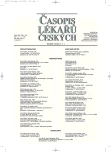Kidney transplantation at the Institute for Clinical and Experimental Medicine
Authors:
Ondřej Viklický; Janka Slatinská; Marcela Bürgelová; Štefan Vítko; Mariana Urbanová; Renáta Lažanská; Vladimír Hanzal; Štěpán Bandúr; Vladimír Teplan; Ivo Matl; Libor Janoušek; Eva Honsová; Monika Drastichová; Jan Malý
Authors place of work:
Institut klinické a experimentální medicíny Praha, Transplantační centrum, Klinika nefrologie
Published in the journal:
Čas. Lék. čes. 2011; 150: 56-59
Category:
Původní práce
Summary
Background:
Kidney transplantation represents the method of choice of end stage renal disease.
Methods and results:
The program of kidney transplantation was established in 1966 in our centre. In recent years, roughly 200 patients have undergone kidney transplantation annually, and 20–30 of them have received a graft from the living donor. Triple immunosuppressive regimen based on tacrolimus, MMF and steroids is given to majority of patients, in a case of high rejection risk; patients have received the induction protocols with polyclonal or monoclonal antilymphocyte globulins. Acute rejection is not a frequent finding in recent years and has occurred in 15% of cases in the first 3 months, the use of induction immunosuppression has decreased the rejection risk. Valgancyclovir has been used as prophylactic agent to prevent and treat cytomegalovirus infection. The usage of this strategy reduced the incidence of CMV infection below 10%. Kidney transplant recipients suffer from similar comorbidities as other renal patients in the long term, as cardiovascular complications, infections and malignancies. Anemia is a frequent complication in patients with graft dysfunction and erythropoesis stimulating agents have been used in its therapy. The median kidney graft survival is 8 years.
Conclusions:
Kidney transplantation is associated with better long-term results when compared with dialysis therapy and thus this method should be offered to all of suitable end stage renal disease patients.
Key words:
end stage renal disease, kidney transplantation, immunosuppression, complications.
Zdroje
1. Meier-Kriesche HU, Schold JD, Srinivas TR, Reed A, Kaplan B. Kidney transplantation halts cardiovascular disease progression in patients with end-stage renal disease. Am J Transplant 2004; 4(10): 1662–1668.
2. http://www.nefrol.cz
3. Oniscu GC, Brown H, Forsythe JL. Impact of cadaveric renal transplantation on survival in patients listed for transplantation. J Am Soc Nephrol 2005; 16(6): 1859–1865.
4. Danovitch GM, Hariharan S, Pirsch JD, Rush D, Roth D, Ramos E, Starling RC, Cangro C, Weir MR. Clinical Practice Guidelines Committee of the American Society of Transplantation. Management of the waiting list for cadaveric kidney transplants: report of a survey and recommendations by the Clinical Practice Guidelines Committee of the American Society of Transplantation. J Am Soc Nephrol 2002; 13(2): 528–535.
5. Womer KL, Kaplan B. Recent developments in kidney transplantation – a critical assessment. Am J Transplant 2009; 9(6): 1265–1271.
6. Solez K, Axelsen RA, Benediktsson H, Burdick JF, Cohen AH, Colvin RB, Croker BP, Droz D, Dunnill MS, Halloran PF, et al. International standardization of criteria for the histologic diagnosis of renal allograft rejection: the Banff working classification of kidney transplant pathology. Kidney Int 1993; 44(2): 411–422.
7. Rubin RH. Importance of CMV in the transplant population. Transpl Infect Dis 1999; 1 (Suppl 1): 3–7.
8. Sagedal S, Hartmann A, Nordal KP, Osnes K, Leivestad T, Foss A, Degré M, Fauchald P, Rollag H. Impact of early cytomegalovirus infection and disease on long-term recipient and kidney graft survival. Kidney Int 2004; 66(1): 329–337.
9. Humar A, Lebranchu Y, Vincenti F, Blumberg EA, Punch JD, Limaye AP, Abramowicz D, Jardine AG, Voulgari AT, Ives J, Hauser IA, Peeters P. The efficacy and safety of 200 days valganciclovir cytomegalovirus prophylaxis in high-risk kidney transplant recipients. Am J Transplant 2010; 10(5): 1228–1237.
10. Vanrenterghem Y, Ponticelli C, Morales JM, Abramowicz D, Baboolal K, Eklund B, Kliem V, Legendre C, Morais Sarmento AL, Vincenti F. Prevalence and management of anemia in renal transplant recipients: a European survey. Am J Transplant 2003; 3(7): 835–845.
11. Molnar MZ, Czira M, Ambrus C, Szeifert L, Szentkiralyi A, Beko G, Rosivall L, Remport A, Novak M, Mucsi I. Anemia is associated with mortality in kidney-transplanted patients—a prospective cohort study. Am J Transplant 2007; 7(4): 818–824.
12. Kamar N, Rostaing L. Negative impact of one-year anemia on long-term patient and graft survival in kidney transplant patients receiving calcineurin inhibitors and mycophenolate mofetil. Transplantation 2008; 85(8): 1120–1124.
Štítky
Adiktologie Alergologie a imunologie Angiologie Audiologie a foniatrie Biochemie Dermatologie Dětská gastroenterologie Dětská chirurgie Dětská kardiologie Dětská neurologie Dětská otorinolaryngologie Dětská psychiatrie Dětská revmatologie Diabetologie Farmacie Chirurgie cévní Algeziologie Dentální hygienistkaČlánek vyšel v časopise
Časopis lékařů českých

- Metamizol jako analgetikum první volby: kdy, pro koho, jak a proč?
- Testování hladin NT-proBNP v časné diagnostice srdečního selhání – guidelines ESC
- Horní limit denní dávky vitaminu D: Jaké množství je ještě bezpečné?
- Antibiotika na nachlazení nezabírají! Jak můžeme zpomalit šíření rezistence?
Nejčtenější v tomto čísle
- Akutní selhání jater: současná doporučení
- Hyperglykémie a její kontrola u dospělých pacientů v intenzivní péči
- Prof. MUDr. Václav Čepelák, DrSc. osmdesátníkem
- Transplantace ledviny v IKEM
